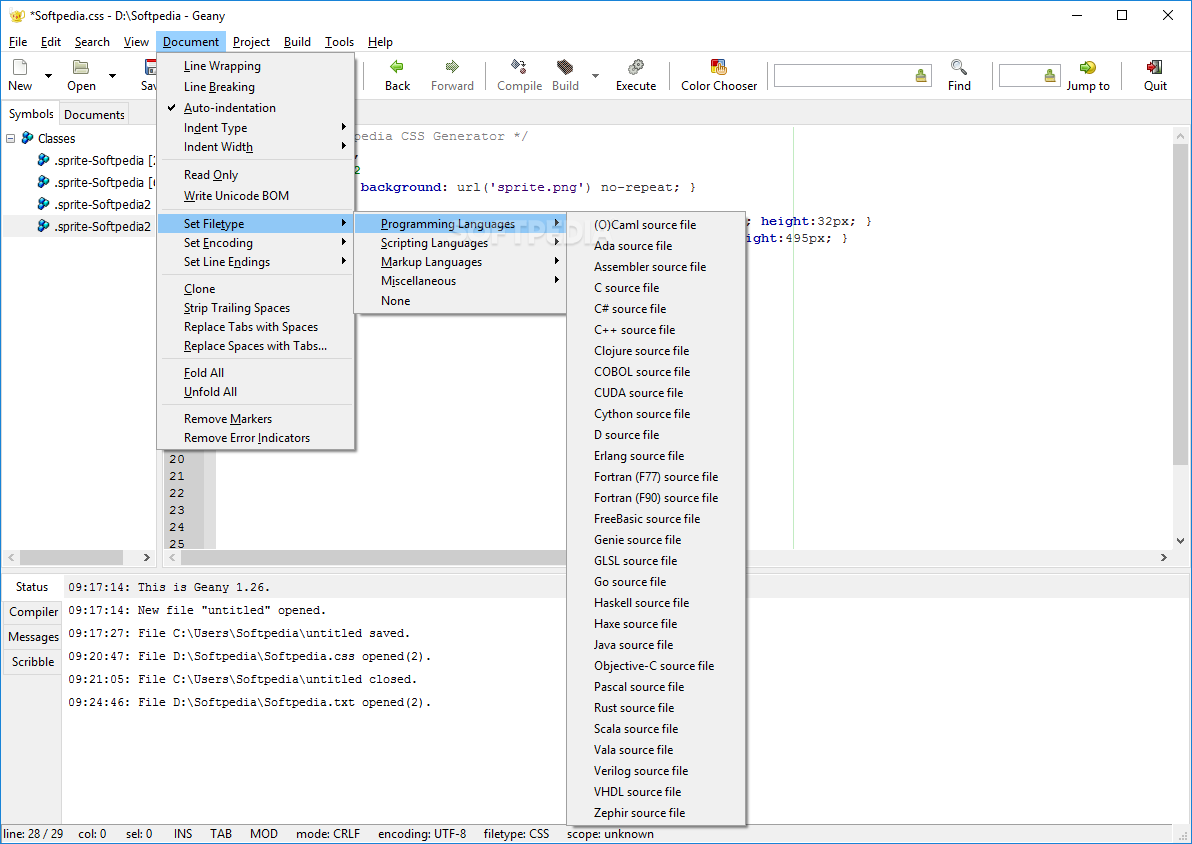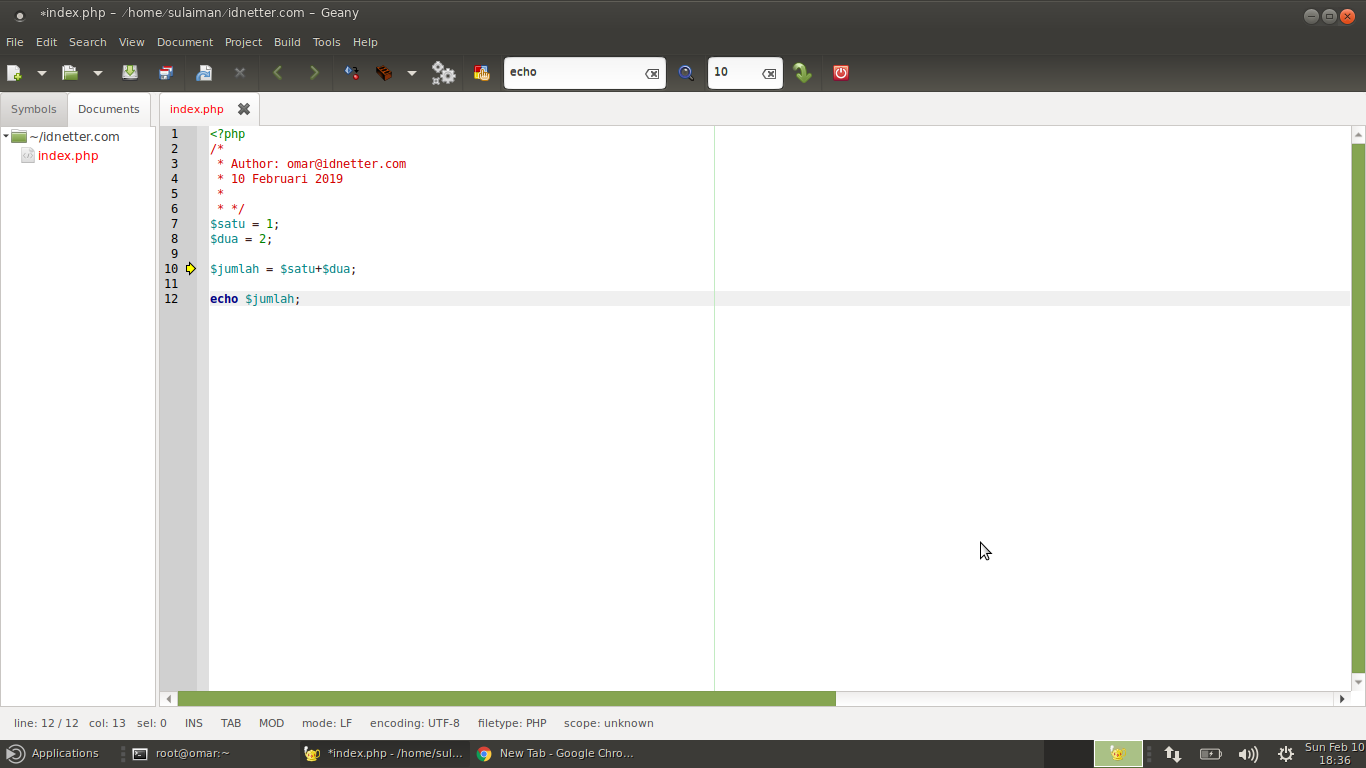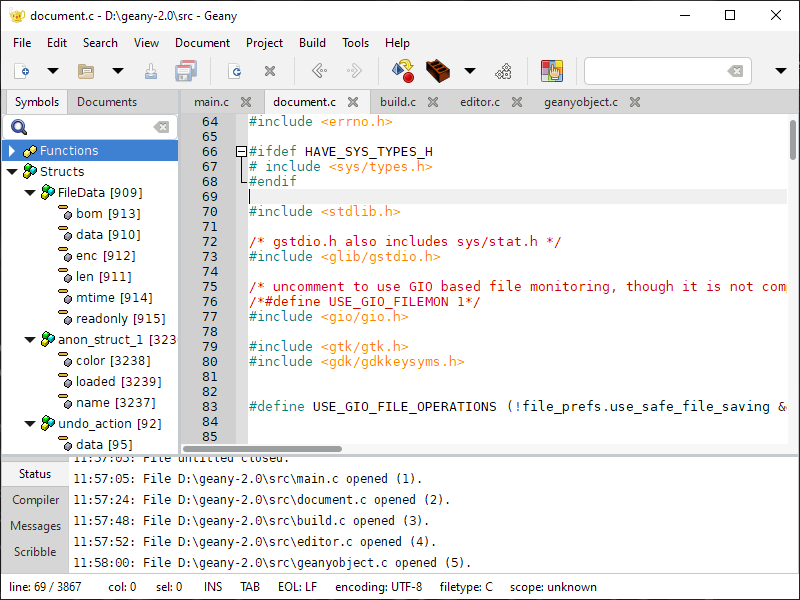
- GEANY EDITOR FOR WINDOWS MAC OS
- GEANY EDITOR FOR WINDOWS MANUALS
- GEANY EDITOR FOR WINDOWS SOFTWARE
- GEANY EDITOR FOR WINDOWS CODE
- GEANY EDITOR FOR WINDOWS WINDOWS
specified rows and columns), and my personal favorite, column cut/copy/paste capability. NEdit (Figure 14) comes with many features, including bracket matching, syntax highlighting, line numbering (basically mandatory for a text editor), a very good search and replace function with which you can use regular expressions, macros, block selection of text (i.e. With few updates since, the last release was version 5.6 in December 2014, which was 10 years after the release of the previous version. According to the Wikipedia article, development of NEdit stopped in 2010.
GEANY EDITOR FOR WINDOWS CODE
I used NEdit on Linux for many years to write a great deal of both code and text. NEdit was built using the Motif toolkit, which was very popular when it was released. It was originally developed at Fermilab, but the version today on Linux was developed as an independent open source project with the GNU GPL license. The first GUI editor I used was NEdit (Nirvana Editor) on SGI workstations running IRIX. On the left-hand side, Kate maintains a list of files that are being edited, so you can switch back and forth.įigure 13: Leafpad 0.8.18.1 on CentOS 6.8. Kate (Figure 1) also allows you to split the screen so you can see two parts of the file at the same time (always a useful feature). When you "unfold," the section of code becomes visible. You can take a section of code and "fold" it so that it is hidden from view. If you haven't used code folding before, you should try it out it can be a useful feature in long code files. Kate has many of the features of a classic editor, including syntax highlighting (based on file extensions), code folding, layouts that can be customized, regular expression support, and more. It has been around a fairly long time starting with KDE 2.2 in 2001.
GEANY EDITOR FOR WINDOWS SOFTWARE
Kate (KDE Advanced Text Editor) is part of the KDE Software Compilation and is considered the KDE text editor. Take a look at JuffEd – it is pretty nifty.

JuffEd has a very large feature set that comparable to the most advanced editors:
GEANY EDITOR FOR WINDOWS WINDOWS
I started using gedit on Windows with version 2.30 (Figure 8) and with about the same version on CentOS 6.x. It performs syntax highlighting with the help of extension files. It has the classic editor features, such as line numbering (absolute necessary in my opinion), bracket matching, text wrapping, syntax highlighting, automatic indentation, and automatic file backup.
GEANY EDITOR FOR WINDOWS MAC OS
This multiplatform editor is available for Linux, Microsoft Windows, and Mac OS X. Gedit is the default text editor for Gnome and is considered part of the Gnome Core Applications. The editor on which I decided for most of my work is gedit. However, it was getting a little old, in some cases crashing on certain distributions, so I started looking at editor options, many of which you are reading about in this article. geditĪ couple of years ago I had a personal editor crisis at about the same time as Joe Landman. Geany is easy to learn, so you can be productive immediately, and if you need an IDE, you can keep using the same tool.

Geany has many of the features of a classic text editor: You can minimize this section to give yourself a larger editor window. It is also cross-platform since it uses web tools such CoffeeScript, Less, and Node.js.Īt the bottom of Figure 7, you can see a feedback area used during compile time. Atom has a large range of default plugins written in Node.js for many languages.Ītom (Figure 5) has become a very popular editor because it's very hackable and it has built-in GitHub controls and Github is where everyone stores their code now. The cross-platform editor is written in CoffeeScript and Less, and it’s embedded Git controls lend a huge appeal to developers.

Although editors and IDEs often overlap, the focus here is on editors.

Text editors strictly allow you to edit text in documents. It’s definitely not an exhaustive list, and I don’t contrast features, but I do try to provide some personal insight into them.Īt this time, I am not considering IDEs, which can also build and execute an application from within the editing environment. I chose open source editors that I have heard about and have, for the most part, experimented with in some fashion. In this section, I want to mention a few GUI editors that seem to be popular.
GEANY EDITOR FOR WINDOWS MANUALS
To be honest, though, the frequency of these situations is much lower than it used to be, so knowing a GUI editor for developing code, processing and reading logs, or writing articles or manuals is a very useful tool. First and foremost, admins should know a CLI editor in case they need to log in to a system on which X is not running or it is not installed. In my opinion, GUI-based editors are a “nice to have” tool in the sys admin’s toolbox I use one every day.


 0 kommentar(er)
0 kommentar(er)
